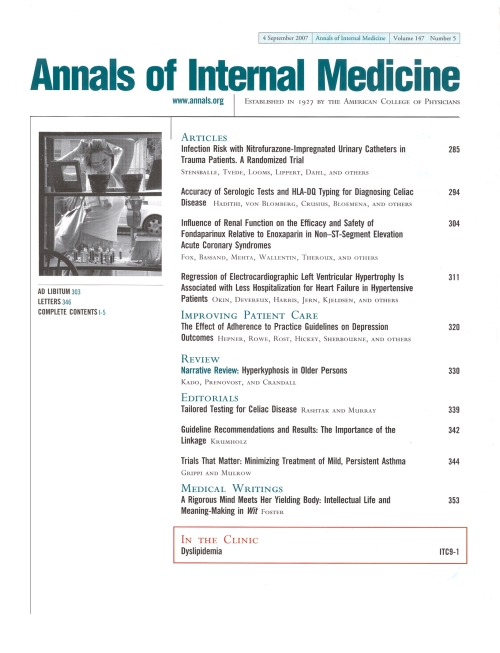Continuing Medical Education
You’re eligible to earn 0.5 CME credits for reading this report.
Generating CME Eligible Questions
Rate your knowledge of the subject matter BEFORE reading this enduring material:
Rate your knowledge of the subject matter AFTER reading this enduring material:
How will you implement this research in your practice?
What barriers may you experience in applying this research in your practice?

Pain, Analgesic Use, and Patient Satisfaction Following Hip Fracture Surgery

Pain, Analgesic Use, and Patient Satisfaction Following Hip Fracture Surgery
Pain, Analgesic Use, and Patient Satisfaction With Spinal Versus General Anesthesia for Hip Fracture Surgery : A Randomized Clinical Trial
Ann Intern Med. 2022 01-Jul;():. 10.7326/M22-0320Did you know you're eligible to earn 0.5 CME credits for reading this report? Click Here
Synopsis
One thousand six hundred patients undergoing surgery for hip fractures were randomized to receive either spinal anesthesia (n=795) or general anesthesia (n=805). Pain scores using the Numerical Rating Scale (NRS) were assessed from postoperative day 1 to 3 and again at 60, 180, and 365 days. Prescription analgesic use was measured at 60, 180, and 365 days postoperatively, and satisfaction with anesthesia care using the Bauer anesthesia satisfaction questionnaire at postoperative day 3 or discharge. Pain scores were similar between the two groups from 24 hours to 365 days postoperatively. The spinal anesthesia group presented with higher rates of analgesic use at 60 days. Satisfaction did not differ between the two groups.
Publication Funding Details
Why was this study needed now?
A large proportion of adults experience a hip fracture that needs surgical treatment. Patients are either given spinal or general anesthesia for this type of surgical procedure. Currently, there is limited evidence on the effects of spinal versus general anesthesia on pain, analgesic use, and satisfaction following a hip surgery after discharge. Previous studies have outlined the effects of these two anesthetic types on outcomes till the patient is discharged but few studies assess these outcomes at later time points. Therefore, a trial was of interest.
What was the principal research question?
In adult patients undergoing surgical repair for their hip fracture, what is the effect of spinal anesthesia on postoperative pain, analgesic use, and satisfaction after 60 days, compared to general anesthesia?
What were the important study characteristics?
1600
Total Sample Size
795
Spinal Anaesthesia
805
General Anaesthesia
Pain
Lower = Better
Scale: 0.0 to 10.0
Pain
Lower = Better
Scale: 0.0 to 10.0
Pain
Lower = Better
Scale: 0.0 to 10.0
Rescue Medication
Lower = Better
Adverse events
Lower = Better
Adverse events
Lower = Better
Adverse events
Lower = Better
Adverse events
Lower = Better
Adverse events
Lower = Better
Adverse events
Lower = Better
Adverse events
Lower = Better
Adverse events
Lower = Better
Adverse events
Lower = Better
Adverse events
Lower = Better
Satisfaction
Lower = Better
Satisfaction
Lower = Better
Randomized Controlled Trial
Locations: Canada, United States
Outcomes: Pain
Outcomes: Pain
Outcomes: Pain
Outcomes: Adverse events, Pain, Satisfaction
Outcomes: Pain, Rescue Medication
Outcomes: Pain, Rescue Medication
Outcomes: Pain, Rescue Medication
What were the important findings?
No significant differences were seen between the two groups after 24 hours postoperatively to 365 days with regard to pain scores. A greater proportion of individuals in the spinal anesthesia group reported the use of analgesics at 60 days postoperatively. Analgesic use at 180 and 365 days was similar between the two groups. With regard to satisfaction, a higher proportion of patients reported a severe sore throat in the general anesthesia group whereas, more patients in the spinal group reported severe shivering. Dissatisfaction with one or more aspects of the anesthesia the patients received, was similar between the two groups.
What should I remember most and how will this affect the care of my patients?
In patients undergoing hip fracture surgery, severe postoperative pain was experienced by both groups. Pain scores after 24 hours postoperatively to 365 days were similar and a higher proportion of individuals reported analgesic use at 60 days in the spinal anesthetic group. The results of this trial were limited by some missing data for each study outcome. Additionally, no data was collected on non-opioid analgesic use postoperatively. Overall, both clinicians should prioritize pain management strategies following hip surgeries.
DISCLAIMER:
The authors responsible for this critical appraisal and ACE Report indicate no potential conflicts of interest relating to the content in the original publication.
Did you know that you’re eligible to earn 0.5 CME credits for reading this report!
Learn about our AI Driven
High Impact Search Feature
Our AI driven High Impact metric calculates the impact an article will have by considering both the publishing journal and the content of the article itself. Built using the latest advances in natural language processing, OE High Impact predicts an article’s future number of citations better than impact factor alone.
Continue



 LOGIN
LOGIN



Join the Conversation
Please Login or Join to leave comments.